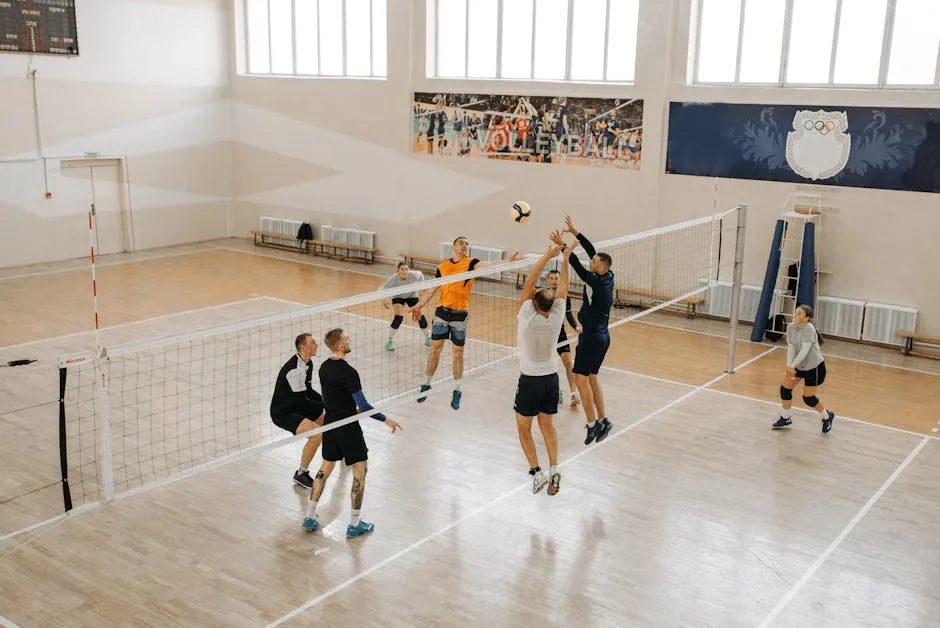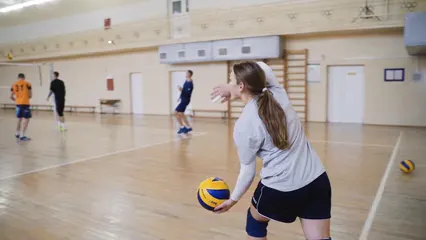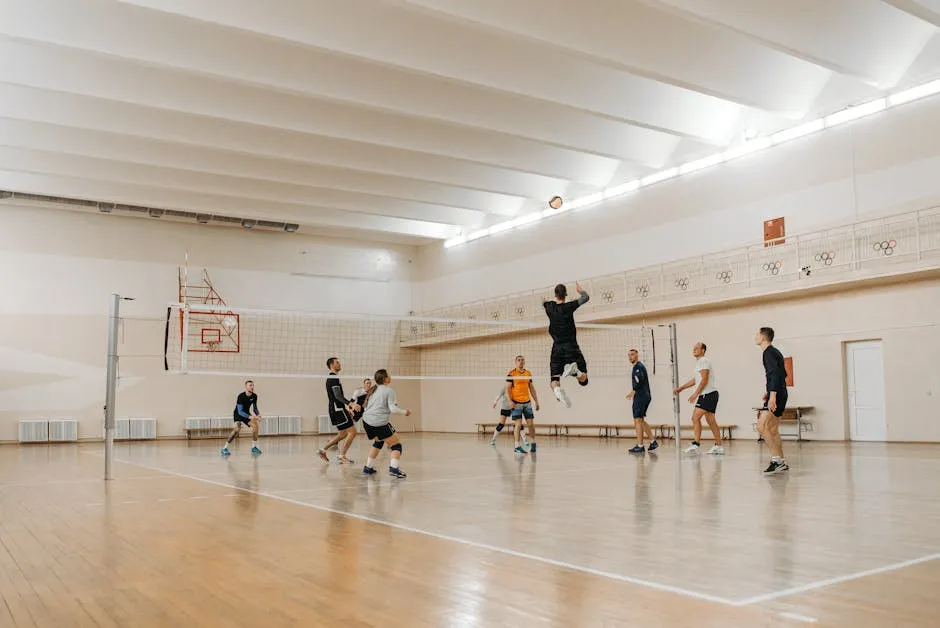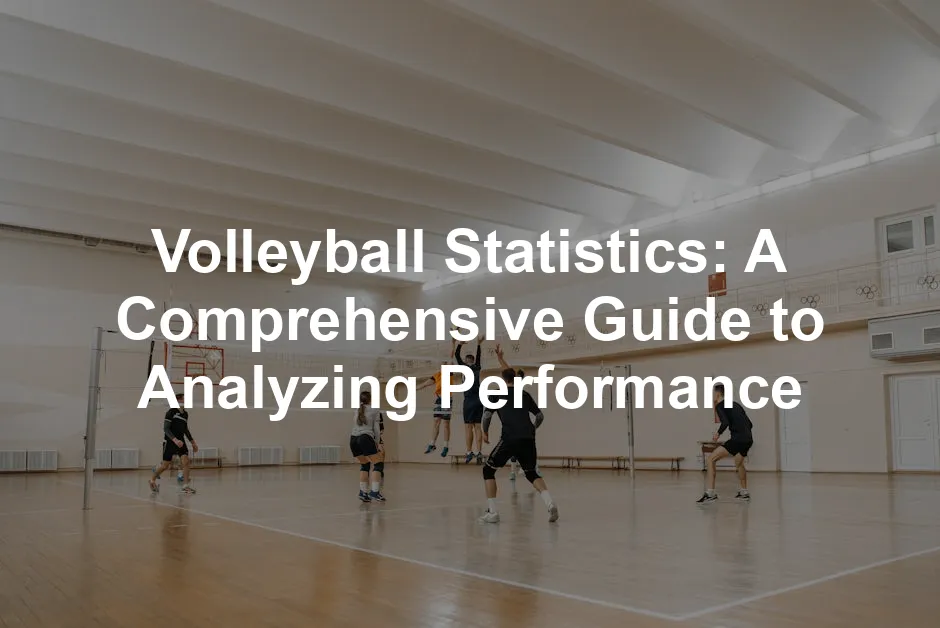Introduction
Volleyball statistics are more than just numbers. They’re the secret sauce behind team strategies, player evaluations, and fan engagement. Coaches and players use these data points to improve performance, analyze strengths and weaknesses, and ultimately win more games. Ever wonder how a coach decides which player to put in during crucial moments? You guessed it—statistics play a pivotal role!
In recent years, the world of sports has embraced data-driven analysis. This transformation is especially evident in volleyball. With advanced technologies, coaches can now track player movements, ball trajectories, and even player fatigue. It’s like having a playbook that writes itself! The more we understand these statistics, the better equipped we are to appreciate the game.
This article serves as your ultimate guide to volleyball statistics. We’ll cover the types of stats you should know, how they’re collected, and their applications in various contexts. Whether you’re a coach, a player, or just a passionate fan, there’s something for everyone here. Prepare to elevate your volleyball knowledge from “just a game” to a strategic masterpiece!

1. Understanding Volleyball Statistics
1.1 Definition of Volleyball Statistics
Volleyball statistics are numerical measurements that reflect player and team performance. These data points can range from basic stats—like points scored—to advanced metrics that analyze player efficiency. Why do these stats matter? They provide insights that help coaches make informed decisions and players identify areas for improvement.
In professional settings, teams often employ data analysts who crunch numbers to reveal trends. Amateur teams can also benefit from statistics, even if they only track a few key metrics. For example, a local high school team might focus on aces and digs to understand their strengths. No matter the level, everyone can find value in volleyball statistics.
If you’re looking to take your game to the next level, consider investing in a Volleyball Net System. It’s essential for practice sessions, ensuring you set up your training environment right. Who wouldn’t want a net that can withstand the test of time and intense spikes?
1.2 Types of Volleyball Statistics
Volleyball statistics can be broadly categorized into three main types:
- Individual Statistics: These stats focus on individual player performance. Key metrics include aces, kills, assists, blocks, and digs. For instance, an “ace” indicates a service that scores a point without being touched by the opponent, while “kills” refer to successful attacks that result in points.
- Team Statistics: These reflect the collective performance of the team. Metrics such as overall win-loss records, total points scored, and serve efficiency are crucial. For example, a team with a high serve efficiency percentage is likely to win more matches. Learn more about team statistics in sports.
- Comparative Statistics: These stats allow for direct comparisons between players or teams. By looking at metrics like head-to-head performance or ranking, coaches and fans can gauge how one team stacks up against another.
1.3 Historical Context
The evolution of volleyball statistics is a fascinating journey. In the early days, tracking player performance relied heavily on manual recording. Coaches scribbled notes and calculated averages by hand. Fast forward to today, and technology has revolutionized how we gather and interpret data.
The introduction of video analysis and tracking software has made it possible to collect a wealth of information during matches. Coaches now use platforms that provide real-time data, allowing them to adjust strategies on the fly. This shift has made volleyball more analytical, paving the way for better player development and strategic planning.
Understanding the historical context of these statistics helps us appreciate the sophistication of modern volleyball analysis. As the sport continues to grow, so too will the depth and complexity of the statistics used to measure success.

2. Key Volleyball Statistics Explained
2.1 Individual Player Statistics
2.1.1 Scoring Statistics
In volleyball, scoring statistics are the lifeblood of a player’s performance. Points, kills, and aces tell the story of how well a player can convert opportunities into points.
Points are the total number of times a player contributes to the scoreboard. Kills, a key component, happen when a player successfully attacks and the ball lands in the opponent’s court. Aces are like icing on the cake—they occur when a player serves the ball in such a way that the opposing team can’t even touch it.
Let’s take a look at the recent Volleyball Nations League (VNL) 2024. T. Štern led the pack with an impressive 320 points, establishing himself as a scoring machine. Nimir from the Netherlands wasn’t far behind, racking up 284 points. These stats highlight how individual scoring can influence a team’s success.
During the Olympic Games in Paris 2024, Leon from Poland managed to score 103 points, showcasing his attacking prowess. The significance of these statistics lies not just in numbers but in their ability to shift momentum during matches. A well-timed ace can turn the tide; just ask any coach!
2.1.2 Defensive Statistics
Defensive statistics are equally crucial to understanding a player’s contribution. Digs and blocks are the two main metrics that paint a picture of a player’s defensive skills.
A dig is a defensive maneuver where a player successfully retrieves an opponent’s attack, preventing the ball from touching the ground. Blocks are defensive moves aimed at stopping an attack before it crosses the net.
For instance, in the VNL 2024, the best digger was Danani from Argentina, recording 123 digs. Comparatively, the best blockers, Le Goff and Bruno from France and Brazil, respectively, each achieved 34 blocks. These figures exemplify how a strong defensive presence can neutralize the opposing team’s offense.
In different leagues, the stats can vary significantly. For example, NCAA teams often emphasize defensive training, resulting in higher block averages compared to international leagues. This variance shows how different contexts can shape player roles and game strategies.

2.2 Team Statistics
2.2.1 Match Performance Metrics
When analyzing team performance, several metrics come into play, including total points, serve efficiency, and reception quality.
Total points scored by a team provide insight into their overall effectiveness. Serve efficiency measures how well a team can serve without errors, while reception quality assesses how effectively a team can handle incoming serves.
In VNL matches, teams with high serve efficiency often dominate. For example, a team that manages to maintain a 90% serve efficiency typically wins more matches. This is particularly important because a strong serve can lead to aces or force the opponent into making mistakes.
To make sure you’re always hydrated during those intense matches, check out this fantastic Sports Water Bottle. Staying hydrated is key to peak performance!
2.2.2 Season Averages
Season averages are another key component of team statistics. These averages allow teams to track performance trends over a longer period.
Using data from the NCAA, we can see how teams progress throughout the season. For example, a team might begin with an average of 2.5 blocks per set but improve to 3.0 by mid-season. This improvement can be a result of focused training and adapting strategies based on previous matches.
Tracking these averages helps coaches adjust their tactics and player roles. A team that consistently improves its blocking average will likely see a corresponding increase in match wins, reflecting the importance of evolving performance metrics throughout a season.

2.3 Advanced Statistics
Advanced statistics take volleyball analytics to a new level, revealing deeper insights into player and team performance. Metrics like efficiency ratings, win shares, and player impact scores provide a comprehensive view of contributions beyond traditional statistics.
Efficiency ratings, for example, assess a player’s overall performance relative to attempts. When you consider kills, errors, and blocks, it becomes clear how effective a player truly is. A high efficiency rating indicates that a player efficiently converts opportunities into successful plays.
Win shares, on the other hand, quantify a player’s contribution to their team’s wins. This metric helps teams understand who the real game-changers are.
Lastly, player impact scores combine various statistics to illustrate a player’s influence on the game. Coaches and analysts value these metrics as they provide context to the numbers—making it easier to identify players who excel not just in scoring but also in facilitating team success.
By embracing advanced statistics, teams can sharpen their strategies, recruit better talent, and ultimately enhance their chances of victory. The world of volleyball is rich with data, and understanding it can make the difference between winning and losing.

3. Methods of Collecting Volleyball Statistics
Volleyball statistics are crucial for understanding performance, both individually and as a team. But how do we gather these numbers? Let’s break down the methods used—from traditional techniques to cutting-edge technology.
3.1 Traditional vs. Modern Methods
Traditionally, volleyball statistics were recorded manually. Coaches and statisticians jotted down every play, every point, and every error on paper. While this method worked, it was time-consuming and prone to human error.
Fast forward to today, and we see a dramatic shift. Automated systems have taken the stage, thanks to advancements in technology. Now, coaches can track player movements and game dynamics with precision. High-tech cameras and tracking software analyze every serve, pass, and spike in real time. This evolution has made data collection easier, faster, and more accurate.
For example, systems like VolleyStats247 allow users to access live scores and detailed statistics, all organized by seasons. These modern methods provide deeper insights with less hassle, transforming how teams approach performance analysis.

3.2 Role of Technology
The impact of technology on volleyball statistics is monumental. Data analytics and software tools have revolutionized performance analysis. Coaches can now break down matches and evaluate individual player contributions with unparalleled clarity.
Tools like VolleyStats247 and Statista offer comprehensive data on player and team performances. They track everything from aces to digs, providing a clear view of how each player contributes to the overall game.
Moreover, sophisticated algorithms analyze trends and predict outcomes. Coaches can adjust strategies based on these insights, tailoring their approaches to exploit opponents’ weaknesses. With technology on their side, teams can make informed decisions that enhance their performance.

3.3 Case Studies
Let’s look at some success stories that highlight the benefits of statistical analysis in volleyball. Take a college team, for instance. By implementing a new analytics platform, they identified that their blocking efficiency was lagging behind the competition.
After analyzing game footage and stats, coaches adjusted training to focus on blocking techniques. They emphasized drills that improved timing and positioning. The results? The team’s blocking average soared from 2.5 to 3.0 blocks per set over the season. This improvement directly correlated with an increase in match victories.
Another example comes from a professional league that adopted real-time analytics. Coaches utilized data during matches to make quick decisions about player substitutions. This strategic use of statistics allowed teams to capitalize on momentum shifts, increasing their chances of winning close games.
These case studies illustrate how embracing statistical analysis can lead to significant performance improvements. By leveraging data insights, teams can refine their strategies, enhance training, and ultimately achieve greater success on the court.

In conclusion, the methods of collecting volleyball statistics have evolved dramatically. From traditional manual entries to advanced automated systems, the landscape is more efficient and insightful than ever. With technology leading the way, teams can harness the power of data to elevate their performance and dominate the competition.

4. Applying Statistics in Coaching and Training
Statistics in volleyball are like the secret sauce in a recipe. They flavor everything from training methods to game strategies. Coaches who harness these numbers make smarter decisions. Let’s explore how statistics enhance training programs, scouting, and game strategies.
4.1 Enhancing Training Programs
Coaches can use statistics to create personalized training programs. Imagine a coach surveying player performance data. They notice Player A has a high kill percentage but struggles with serve reception. With this insight, the coach can design specific drills to improve reception skills.
For instance, if a team’s serve efficiency is below average, the coach might implement serve-receive drills. These can focus on footwork and positioning. By analyzing statistics, coaches can target areas needing improvement, creating a more effective training regimen.
Statistics can also identify which drills yield the best results. If data shows that players improve their serve accuracy after specific training sessions, those drills become essential. Coaches can adjust practice schedules based on statistical evidence, ensuring every minute on the court counts.
Consider a real-life example: a college team identified their blocking average was lower than their competitors. Based on this statistical insight, the coaching staff introduced targeted blocking drills. They focused on timing and teamwork. The result? A noticeable increase in their blocking efficiency during matches.

4.2 Scouting and Recruiting
Statistics play a significant role in scouting and recruiting. Coaches analyze player stats to identify talent. High school players with impressive stats can catch a coach’s eye. But it’s not just about the numbers; it’s about interpreting them correctly.
Common recruiting mistakes include focusing solely on points scored. A player might excel in scoring but struggle in other critical areas, like defense. By examining comprehensive statistics, coaches can gain a fuller picture of a player’s abilities.
For example, a coach might discover that a player has a high kill rate but also a high error rate. This insight can prompt further questioning: Is the player making risky decisions? Understanding these nuances helps coaches make better recruitment choices.
Furthermore, data can mitigate biases. Coaches may fall in love with flashy players who score a lot. Analyzing statistics can reveal hidden gems who contribute significantly to team success in less obvious ways.
Statistics empower coaches to avoid oversights. By looking at metrics like digs, blocks, and assists, they can ensure they’re recruiting well-rounded players.

4.3 Game Strategy Development
Teams leverage statistics to develop strategies against opponents. Analyzing the stats from previous matches can reveal an opponent’s strengths and weaknesses. For example, if a team notices that an opponent has a weak serve reception rate, they might adjust their serving strategy to exploit this flaw.
Consider a scenario where a team discovers that their opponents struggle against fast serves. The coach can instruct players to focus on powerful, quick serves during the match. This tactical adjustment can turn the tide in a tightly contested game.
Another example involves defensive setups. If a team analyzes data showing that an opposing player consistently scores from one position, they can adjust their defense accordingly. They might assign an extra blocker to that zone, effectively shutting down the opponent’s most potent weapon.
Statistics provide a treasure trove of insights. Coaches can use player performance data to refine match strategies. If a player excels in spikes but struggles in defense, the coach might adjust rotations to maximize strengths while minimizing weaknesses.
In summary, the application of statistics in volleyball is multifaceted. Coaches can enhance training programs, make informed recruitment decisions, and develop game strategies that exploit opponents’ weaknesses. By embracing data-driven approaches, teams can elevate their performance and compete at higher levels. Statistics are not just numbers; they’re the key to unlocking volleyball success.

5. The Future of Volleyball Statistics
5.1 Trends in Data Analysis
Emerging technologies are transforming sports analytics, and volleyball is no exception. Artificial intelligence (AI) and machine learning are stepping onto the court like a star player. These technologies analyze vast amounts of data, offering insights that were once unimaginable.
Imagine a system that tracks player movements, predicts performance trends, and identifies weaknesses in real time. That’s the future we’re heading towards! Coaches will rely on AI to create tailored strategies against opponents, ensuring their teams stay one step ahead.
As these technologies evolve, we can expect them to integrate seamlessly with existing systems. Real-time data collection will become standard, allowing for instant feedback during matches. With advanced algorithms, we’ll see predictive analytics that not only enhance player performance but also elevate the overall game experience.

5.2 The Role of Fan Engagement
Statistics are proving to be a game-changer for fan engagement. Fans are no longer passive spectators; they crave interactive experiences. Fantasy leagues and live stats during matches are just the tip of the iceberg. Statistics can enhance the thrill of watching a game, making fans feel like they’re part of the action.
The growth of volleyball viewership is closely tied to this statistical engagement. Fans want to know more about their favorite players and teams. They thrive on stats like kills, digs, and serve efficiency. This thirst for knowledge is driving platforms to provide deeper insights, making every match a data-rich experience.
As volleyball continues to gain popularity, expect to see more interactive content that highlights key statistics. Fans will demand features that allow them to track player progress and compare stats across matches. If you thought a good game was exciting, just wait until you see the stats that bring it to life!

FAQs
What are the most important volleyball statistics to track?
When it comes to volleyball, several key statistics are vital for both players and coaches. Here are the top stats to keep an eye on: – **Aces**: Points scored directly from serves. – **Kills**: Successful attacks that result in points. – **Blocks**: The number of successful defensive plays against attacks. – **Digs**: Successful defensive plays that prevent the ball from touching the ground. – **Assists**: Successful sets leading to kills. Tracking these metrics gives coaches and players a clear picture of performance and areas needing improvement.
How can I improve my volleyball statistics?
Improving your volleyball statistics requires focus and dedication. Here are some tips: – **Targeted Training**: Work on specific skills, like serving or blocking, based on your weak areas. – **Consistent Practice**: Regularly train to refine your techniques and improve your stats. – **Video Analysis**: Record your matches and analyze your performance to identify areas for growth. – **Set Goals**: Establish clear, measurable goals for each game or practice session. With commitment and the right strategies, you’ll see those stats climb!
Where can I find volleyball statistics?
Accessing volleyball statistics has never been easier. Here are some great resources: – **VolleyballStats247**: Offers live scores and detailed stats for various competitions. – **NCAA**: Provides statistics for college volleyball teams and players. – **Volleyball World**: Features statistics from international competitions, including VNL and Olympic Games. These platforms keep you updated on player performance, team rankings, and more.
How do volleyball statistics differ from other sports?
Volleyball statistics have unique characteristics compared to sports like basketball or soccer. In volleyball, stats focus heavily on individual contributions, such as aces, digs, and blocks. In contrast, basketball emphasizes overall team performance metrics, like points per game and rebounds. Moreover, volleyball has a more complex scoring system, making advanced metrics like efficiency ratings crucial for understanding a player’s impact. Each sport uses statistics to enhance performance, but the metrics and their applications can vary significantly.
Please let us know what you think about our content by leaving a comment down below!
Thank you for reading till here 🙂
And if you’re looking to enhance your training sessions, don’t forget to check out the Volleyball Training Equipment Set. It’s perfect for practicing your skills and getting that competitive edge!
Lastly, for those post-game recovery sessions, consider using a Foam Roller for Muscle Recovery to ease those tight muscles. Your body will thank you!
All images from Pexels




